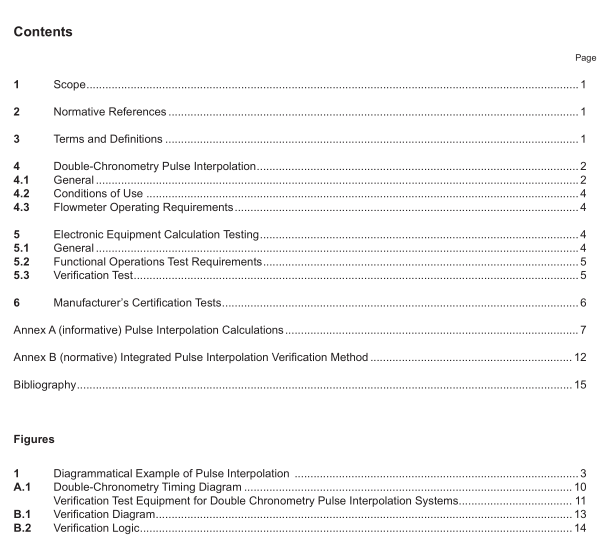API MPMS 4.6 pdf download

API MPMS 4.6 pdf download Manual of Petroleum Measurement Standards Chapter 4.6
1 Scope
This chapter describes how the double-chronometry method of pulse interpolation, including system operatingrequirements and equipment testing, is applied to meter proving.
2Normative References
The following documents are referred to in the text in such a way that some or all of their content constitutesrequirements of this document. For undated references, the latest edition of the reference document (includingany amendments) applies.
API MPMS Chapter 4.2,Displacement Provers3 Terms and Definitions
For the purposes of this document, the following terms and definitions apply. Terms of more general use may befound in the API MPMS Chapter 1, Online Terms and Definitions Database.Acronyms are defined in the text atfirst use.
3.1
detector signal
A contact closure change or other signal that starts or stops a prover counter or timer and defines the calibratedvolume of the prover.
3.2
double-chronometry (dual chronometry)
A pulse interpolation technique used to increase the discrimination level of flowmeter pulses detected betweenprover detector signals. This is accomplished by resolving these pulses into a whole number of pulses plus afractional part of a pulse using two high-speed timers,associated logic,detector signals, and the flowmeterpulses.
3.3
flowmeter discrimination
A measure of the smallest increment of change in the pulses per unit of the quantity being measured.
3.4
frequency
The number of repetitions, or cycles, of a periodic signal (e.g.,pulses, alternating voltage,or current) occurringin a 1-second time period.The number of repetitions, or cycles, that occur in a 1-second period is expressed inhertz.
3.5
meter pulse continuity
The deviation of the interpulse period of a flowmeter expressed as a percentage of a full pulse period.
3.6
nonrotating meter
Any metering device for which the meter pulse output is not derived from mechanical rotation as driven by theflowing stream.For example, vortex shedding, Venturi tubes, orifice plates, sonic nozzles, ultrasonic, direct massflow meters (Coriolis), and electromagnetic flowmeters are metering devices for which the output is derived fromsome characteristic other than rotation that is proportional to flow rate.
3.7
pulse period
The reciprocal of pulse frequency (i.e., a pulse frequency of 2 Hz is equal to a pulse period of 0.5 second).
3.8
pulse generator
An electronic device that can be programmed to output voltage pulses of a precise frequency or time period.
3.9
pulse interpolation
Any of the various techniques by which the meter pulses are counted between two events (such as detectorswitch closures), whereby any remaining fraction of a pulse between the two events is calculated.
3.10
rotating meter
Any metering device for which the meter pulse output is derived from mechanical rotation as driven by the flowingstream. For example, turbine and positive displacement meters are metering devices for which the output isderived from the continuous angular displacement of a flow-driven member.
3.11
signal-to-noise ratio
The ratio of the magnitude of the electrical signal to that of the electrical noise.
4Double-Chronometry Pulse Interpolation
4.1General
Double-chronometry pulse interpolation requires counting the total integer (whole) number of flowmeter pulses,N.. generated during the proving run and measuring the time intervals, T , and T. T , is the time interval betweenthe first flowmeter pulse after the first detector signal and the first flowmeter pulse after the last detector signal.T is the time interval between the first and last detector signals.
The pulse counters, or timers, are started and stopped by the signals from the prover detector or detectors. Thetime intervals T, corresponding to N. pulses,and T, corresponding to the interpolated number of pulses (N.).are measured by an accurate clock.The interpolated pulse count is given as follows:









